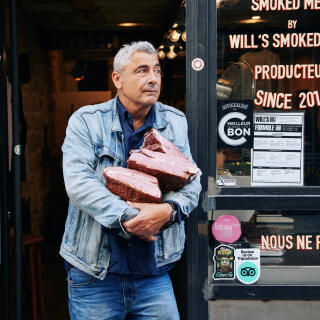Where can you find the best pastrami sandwich? With its crusty bread, tender, cheese-infused meat, and just the right balance of acidity from sauerkraut and sweetness from Thousand Island dressing, the Reuben at Will's Deli in Paris is a hit. The little sandwich shop located in the Sentier neighborhood is always busy. Its owner, William Benitah, plans to expand the brand in Paris and its suburbs in the coming months.
Yet nothing predisposed the 64-year-old entrepreneur to become a pastrami specialist: Benitah used to be a vegetarian and worked as a salesperson in the construction industry. After his wife, Isabelle, convinced him to eat meat again, a cousin introduced him to a pastrami sandwich in Montreal in 2011 that changed his life. He discovered "an explosion of spicy, smoky flavors, the tenderness of the meat and the warmth of the crusty bread. It was love at first sight!"
Benitah quit his job and started making pastrami. He supplied five-star hotels (George V), celebrity chefs' restaurants (Joël Robuchon, Yoni Saada), luxury grocery stores (Fauchon, Kaviari) and bakers (Cédric Grolet). In 2020, spurred on by his success and supported by his wife and sons, Simon and Sacha, he took the plunge and opened Will's Deli in order to transform his own product into the sandwich of his dreams.
Do you have a childhood memory of pastrami?
Not a very good one! [In Paris in the 1960s], we ate it cold, without seasoning. It was pretty bland. My mother used to buy it in kosher butcher shops or delis on Rue des Rosiers. She was Sephardic, and didn't know how to prepare it – it's really a product of Ashkenazi culture.
What is the history of pastrami?
It was born in Eastern Europe, probably in Romania [its name comes from the Romanian "pastra," meaning "to preserve"]. Over there, people ate a lot of potatoes and cabbage with pork. The Ashkenazim looked for an alternative to pork. Most of them were quite poor and made do with the cheapest meat: brisket, which is a tough, fatty part that needs to be simmered for a long time. They first put it in brine to destroy the collagen, then tenderized it in vegetable stock. They found that adding spices improved both taste and preservation – among other things, pepper is bactericidal. Once ready, the meat was placed on top of the sauerkraut for reheating.
When did pastrami become a sandwich?
In the 19th century, Jews who migrated to the United States and Canada adapted the recipe to their new environment. Instead of pepper and coriander, they used mustard seeds, allspice and paprika. In Europe, smoking lasted for quite a while, at low temperatures, to infuse the meat deeply. North American grill culture made it evolve towards more powerful smoking, with the meat marked on the outside but not necessarily deeply smoked on the inside. And, finally, a sauerkraut dish that used to be eaten on a plate was transformed into a more practical sandwich, generally called a Reuben [the origin of this designation is the subject of debate].
Is sauerkraut still used in the sandwich recipe?
Yes, but we should not use the word "sauerkraut," otherwise customers get a mental block! When you say "fermented," people think "probiotics that are good for the gut."
Which spice blend do you choose?
There are as many spice blends as there are Jews who make pastrami! Jewish cuisine is basically a poor man's cuisine, where you make do with what you've got and replace it with something else when you don't have what you need! I was inspired by the Canadian recipe, with allspice, mustard and eight different spices. As I travel the world's delicatessens, I refine my recipe!
Do you follow the original Reuben recipe?
Traditionally, North American Jews use rye bread with a very dense crumb, [and] caraway and poppy seeds, which is quite stifling. I don't want to add insult to injury, but neither Ashkenazim nor Americans have the reputation of being excellent bakers! At Will's, we work with a baker to make us sourdough in the French tradition, with a hint of rye. The result is close to a country loaf, slightly crusty. But since many customers don't feel like chewing too much and ask us for burger-style buns, we are developing a rye-based brioche bun.
Do you use kosher meat?
When I started making pastrami, I asked various slaughterhouses to supply me with meat, and the only ones that replied were kosher. But I'm looking for other suppliers in order to have organic beef and breeds other than Charolais, Limousin or Normande.
A sandwich with meat and cheese is not kosher anyway...
Yes, but some customers tell me that it's okay to eat cheese with meat if the meat is kosher. Others don't mix meat and cheese, but they don't wait the required three hours either: they have a cheesecake straight after their sandwich. Kosher is subject to many interpretations!
Is pastrami a fatty meat?
An Ashkenazi will tell you that it's not pastrami if there's no fat! Beef brisket is naturally made up of alternating muscle and fat, and when it melts as it heats up in the sandwich, the fat acts as a flavor enhancer. But many customers ask us to remove the vein of fat when there is some, whereas, paradoxically, on a rib steak, it's fine.
What's Thousand Island dressing made of?
Essentially mayonnaise, ketchup and sweet relish – large pickles cut into a mirepoix and cooked with vinegar and sugar. Then it's up to each person to add their own personal touch, [like] vegetables such as carrots or cauliflower, cut very small to get the taste without the texture. But sorry, I can't tell you my secret ingredient. It's what sets me apart from the competition!
In this series, six chefs reveal how they have adapted a common foreign dish to French tastes and ingredients.
